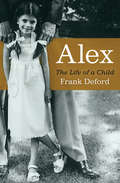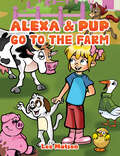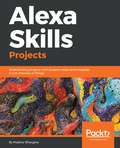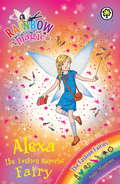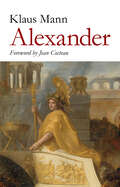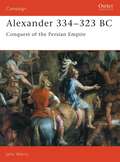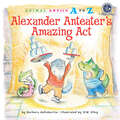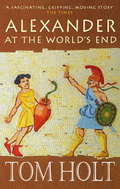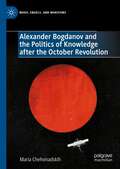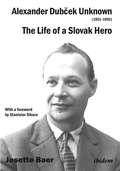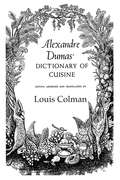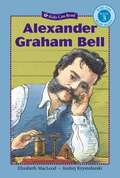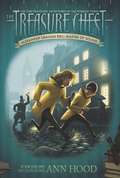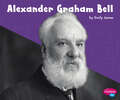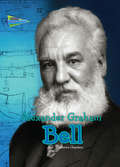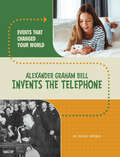- Table View
- List View
Alex: The Life of a Child
by Frank DefordA father&’s moving memoir of cystic fibrosis &“captures a brave child&’s legacy as well as the continuing fight against the genetic disease&” (The New York Times). In 1971 a girl named Alex was born with cystic fibrosis, a degenerative genetic lung disease. Although health-care innovations have improved the life span of CF patients tremendously over the last four decades, the illness remains fatal. Given only two years to live by her doctors, the imaginative, excitable, and curious little girl battled through painful and frustrating physical-therapy sessions twice daily, as well as regular hospitalizations, bringing joy to the lives of everyone she touched. Despite her setbacks, brave Alex was determined to live life like a typical girl—going to school, playing with her friends, traveling with her family. Ultimately, however, she succumbed to the disease in 1980 at the age of eight. Award-winning author Frank Deford, celebrated primarily as a sportswriter, was also a budding novelist and biographer at the time of his daughter&’s birth. Deford kept a journal of Alex&’s courageous stand against the disease, documenting his family&’s struggle to cope with and celebrate the daily fight she faced. This book is the result of that journal.Alex relives the events of those eight years: moments as heartwarming as when Alex recorded herself saying &“I love you&” so her brother could listen to her whenever he wanted, and as heartrending as the young girl&’s tragic, dawning realization of her own very tenuous mortality, and her parents&’ difficulty in trying to explain why. Though Alex is a sad story, it is also one of hope; her greatest wish was that someday a cure would be found. Deford has written a phenomenal memoir about an extraordinary little girl.
Alexa & Pup Go to the Farm
by Lee MatsonOff Alexa and Pup go, hand in paw, excited to see what the farm has in store, Mooing cows and knitting sheep, flapping ducks and goats that leap, Alexa and Pup, the best of friends, will there be a surprise at the end? This charming children’s story is sure to delight and surprise.
Alexa For Dummies
by Paul McFedriesUpgrade your Echo expertise with this Dummies guide to all things Alexa Amazon's hugely popular family of Echo devices has made Alexa a household name. She can answer your questions, entertain you, and even help around the house. Alexa for Dummies is the perfect guide for Alexa users who want to get up and running with their Echo devices. From basic setup to making the most of Alexa’s powerful smart home capabilities, this is your one-stop resource to all things Alexa. Whether you’ll use Alexa to send text messages, play music, control your thermostat, look up recipes, replenish your pantry, or just search the internet for information, you’ll find detailed instructions in this fun and easy-to-understand guide. Set up and personalize your Alexa device with an Amazon account and custom settings, including your preferred Alexa voice Use Alexa to play music throughout your home, stream videos online, and meet all your entertainment needs Unlock the power of advanced features like Alexa Skills and make your Alexa accessible Turn your ordinary house into a modern smart home with advanced smart home features and Echo accessories The virtual assistant you've dreamed of is now a reality with your favorite Echo device. Let Alexa For Dummies make your wish Alexa's command.
Alexa For Dummies
by Paul McFedriesIs there an Echo® in here? Alexa is the voice-controlled Amazon service that transforms your home-sweet-home into a smart home. And Alexa For Dummies is the companion guide that will help you figure out which Echo® device is right for you so you can start training Alexa to be your personal assistant-extraordinaire. This book shows you how to make the most of everything Alexa can do—and that’s a lot! Whether you simply want to play audio or you’re ready to explore Alexa’s higher-level capabilities, we’ve got you covered. Inside... Personalize your Echo® device Enhance security and privacy Ask questions Alexa understands Discover Alexa’s accessibility features Make lists and send texts Set up smart home Wi-Fi Automate your home with routines Install new Alexa skills
Alexa Hampton: Design, Style, and Influence
by Alexa HamptonFrom Alexa Hampton, one of today&’s greatest interior designers and owner of Mark Hampton LLC, comes a beautifully photographed memoir about her journey into design and the inspirations that shaped her iconic style.The anatomies of my chosen surrounding are rich with meaning, authentic and borrowed, and are a snapshot (or many snapshots) of a lifetime spent in the world of design.In her newest book, Alexa Hampton takes you on a journey through her life&’s work: her beautifully appointed pre-war apartment on 59th street in Manhattan. She highlights the art, textiles, and objects in her spaces, along with the design and fashion tastemakers who inspired their use. In doing so, she acknowledges some of the big movements, auctions, and people that rocked the world of design and made an indelible mark on her.An intimate look into Alexa&’s personal design process, including the countless updates and redecorations of her own home, this book is a personal history of interior design and a love letter to an iconic home.
Alexa Is Stealing Your Job: The Impact of Artificial Intelligence on Your Future
by Rhonda ScharfThis guided tour of how AI will impact the future of work explores the ways both companies and employees can adapt to the new normal. Artificial intelligence is taking over. Ask Alexa to call a client or confirm your schedule for the day and she does so immediately. Ask her a question, give her a command, or just share a joke together, and she becomes your new best employee—one who never makes a mistake or calls out sick. In other words, Alexa can nix the need for millions of front-line workers. As companies race to keep up with advances in AI, employees must race just to keep their job. Author and public speaker Rhonda Scharf shows readers how a willingness to adapt to the new normal keeps both businesses and their employees relevant in these changing times. Alexa Is Stealing Your Job reveals what the future entails by diving into the world of AI and exploring how it impacts lives, careers, and the future.
Alexa Skills Projects: Build exciting projects with Amazon Alexa and integrate it with Internet of Things
by Madhur BhargavaGet up and running with the fundamentals of Amazon Alexa and build exciting IoT projectsKey Features Gain hands-on experience of working with Amazon Echo and Alexa Build exciting IoT projects using Amazon Echo Learn about voice-enabled smart devicesBook DescriptionAmazon Echo is a smart speaker developed by Amazon, which connects to Amazon’s Alexa Voice Service and is entirely controlled by voice commands. Amazon Echo is currently being used for a variety of purposes such as home automation, asking generic queries, and even ordering a cab or pizza.Alexa Skills Projects starts with a basic introduction to Amazon Alexa and Echo. You will then deep dive into Alexa Programmingconcepts such as Intents, Slots, Lambdas and maintaining your skill’s state using DynamoDB. You will get a clear understanding of how some of the most popular Alexa Skills work, and gain experience of working with real-world Amazon Echo applications. In the concluding chapters, you will explore the future of voice-enabled applications and their coverage with respect to the Internet of Things.By the end of the book, you will have learned to design Alexa Skills for specific purposes and interact with Amazon Echo to execute these skills.What you will learnUnderstand how Amazon Echo is already being used in various domainsDiscover how an Alexa Skill is architectedGet a clear understanding of how some of the most popular Alexa Skills workDesign Alexa Skills for specific purposes and interact with Amazon Echo to execute themGain experience of programming for Amazon EchoExplore future applications of Amazon Echo and other voice-activated devicesWho this book is forAlexa Skills Projects is for individuals who want to have a deep understanding of the underlying technology that drives Amazon Echo and Alexa, and how it can be integrated with the Internet of Things to develop hands-on projects.
Alexa the Fashion Reporter Fairy: The Fashion Fairies Book 4 (Rainbow Magic #4)
by Daisy MeadowsKirsty and Rachel are excited to be entering a charity fashion show where children get to show off their own designs. Unfortunately, Jack Frost thinks everyone in the world should dress like him, and steals the Fashion Fairies' seven magical items to put his naughty plan into action! The fashion reporter from the Tippington Times is having a terrible day - she muddles up her words, forgets her notepad and generally gets in a fluster. Can Kirsty and Rachel help her out?
Alexander
by Klaus Heinrich Thomas MannThis historical fantasy, written by the son of the well-known German novelist Thomas Mann, takes Alexander the Great for its subject, charting his life and career, and examining his obsession with conquest and supremacy, regardless of its effects on his friends and lovers. Written in 1920s Germany in the aftermath of World War I, this timeless story can also be viewed as a fascinating study of power with highly political connotations. Alexander is a captivating early work of historical fiction from a troubled and unjustly neglected writer.
Alexander 334-323 BC
by John WarryAlexander of Macedonia was undoubtedly one of the greatest generals of all time. This book, by John Warry, an expert on the warfare of the Classical world, examines the principle battles of Alexander's campaigns in detail. The battles of the Granicus, Issus, Gaugamela, Hydaspes and the difficult siege of Tyre are all discussed at length. These careful studies shed light on Macedonian tactics: in particular the combination of armoured infantry phalanx with fast-moving cavalry. The men and equipment of both Alexander and his Persian enemies are also examined, providing a comprehensive insight into Alexander's life and military actions.
Alexander Anteater's Amazing Act (Animal Antics A to Z)
by Barbara deRubertisGet to know Alpha Betty&’s class in the award-winning, 26-book alphabet series ANIMAL ANTICS A TO Z! From Alexander Anteater to Zachary Zebra, it&’s one adventure after another. Zip along with these zany characters as they find new friends, test their talents, and have a rip-roaring good time! Alexander wants to have an amazing act for the talent show. He can already stand on his hands—but can his pals help make his act even more fantastic? This series is a perfect read-aloud choice to help kids discover the joy of letter sounds and give them the phonics building blocks they need for reading success. With delightful illustrations by Paddington Bear illustrator R.W. Alley, ANIMAL ANTICS A TO Z is an excellent resource for parents and educators alike. Activities in each book plus free activities online add to the fun.
Alexander At The World's End
by Tom Holt'Wry and droll, fascinating and funny, by bringing us Alexander's nether parts this novel gives momentous matters unforgettable life' - Ross Leckie'Witty, ironic ... and achieves a deeply felt authenticity' - NEW YORK TIMESWhen his father dies, and he is reduced at a stroke from prosperity to penury, Euxenus decides to leave Athens and seek his fortune elsewhere. As a philosopher and intellectual of some note, he has no difficulty getting a job as tutor to a young prince in the wealthy but utterly provincial court of King Philip of Macedon. The young prince is called Alexander, and the rest is history. Or is it? Alexander conquered Greece, Egypt and the Persian Empire in the course of eight years, amassing a huge army along the way, and leaving behind him the foundations of countless new cities named after him. He proclaimed himself a deity, and died at the age of 33. In ALEXANDER AT THE WORLD'S END, Tom Holt tells the story of two remarkable men, one of whom conquered empires and one of whom struggled to overcome the drainage problems of a small village. It is a story of two men whose paths crossed only briefly, but whose encounter changed both their lives for ever. And it is a story which throws an extraordinary new light on the man who became Alexander the Great.Books by Tom Holt:Walled Orchard SeriesGoatsongThe Walled OrchardJ.W. Wells & Co. SeriesThe Portable DoorIn Your DreamsEarth, Air, Fire and CustardYou Don't Have to Be Evil to Work Here, But It HelpsThe Better MousetrapMay Contain Traces of MagicLife, Liberty and the Pursuit of SausagesYouSpace SeriesDoughnutWhen It's A JarThe Outsorcerer's ApprenticeThe Good, the Bad and the SmugNovelsExpecting Someone TallerWho's Afraid of BeowulfFlying DutchYe Gods!OvertimeHere Comes the SunGrailblazersFaust Among EqualsOdds and GodsDjinn RummyMy HeroPaint your DragonOpen SesameWish you Were HereAlexander at World's EndOnly HumanSnow White and the Seven SamuraiOlympiadValhallaNothing But Blue SkiesFalling SidewaysLittle PeopleSong for NeroMeadowlandBarkingBlonde BombshellThe Management Style of the Supreme BeingsAn Orc on the Wild Side
Alexander Bandelli (A)
by Thomas J. Delong Catherine ConneelyAlexander Bandelli has the opportunity to redefine the way real estate business is done in the Northeast region. He has just joined Ronsini and Fitch and has been asked by senior management to move to a client focus rather than the older, traditional transaction focus. Alexander has many challenges before him. How should he prioritize his work? Does he focus outside the organization or internally? Is the organization prepared for this change project? What should he do first?
Alexander Bogdanov and the Politics of Knowledge after the October Revolution (Marx, Engels, and Marxisms)
by Maria ChehonadskihIn this book, Maria Chehonadskih unsettles established narratives about the formation of a revolutionary canon after the October Revolution. Displacing the centre of gravity from dialectical materialism to the rapid dissemination, canonisation and decline of a striking convergence of empiricism and Marxism, she explores how this tendency, overshadowed by official historiography, establishes a new attitude to modernity and progress, nature and environment, agency and subjectivity, party and class, knowledge and power. The book traces the adventure of the synthesis of empiricism and Marxism across philosophy, science, politics, art and literature from the 1890s to the 1930s, offering a radical rethinking of the true scope and scale that the main proponent of Empirio-Marxism, Alexander Bogdanov, had on the post-revolutionary socialist legacies. Chehonadskih draws on both key and forgotten figures and movements, such as Proletkult, Productivism and Constructivism, filling a gap in the literature that will be particularly significant for Marxism, continental philosophy, art theory and Slavic studies specialists.
Alexander Dubček Unknown (1921–1992): The Life of a Political Icon
by Josette Baer HillAlexander Dubček is well-known, so one might think; nothing new can be written about him. Is this true? Dubček is the symbol of the Czechoslovak attempt to reform communism that gained worldwide admiration in 1968. The invasion of Warsaw Pact troops in the night of August 21, 1968 set a brutal end to the Prague Spring.Josette Baer’s new biography focuses on Dubček’s early years, his childhood in Soviet Kirghizia, his participation in the Slovak National Uprising in 1944 against Nazi Germany and the Slovak clerical-fascist government, and his career in the Slovak Communist Party in the late 1950s and early 1960s. <P><P> It offers new insights into the political thought of the father of “Socialism with a Human Face,” based on archive material available to the Western reader for the first time. Who was Alexander Dubček—a naïve apparatchik, an independent thinker, a courageous liberator, or a political dreamer?
Alexander Dumas Dictionary Of Cuisine
by DumasFirst published in 2005. A cookery book by the author of The Three Muskateers and The Count of Monte Cristo may seen an improbability. Yet Alexandre Dumas was an expert cook- his love of food was said to be equalled only by his love of women - and his Great Dictionary of Cuisine, written to be read by worldly people and used by professionals and published posthumously in 1873, it is a masterpiece in its own right. This abridged version of the Dictionary is designed to be both useful and entertaining. A glance at the Index will show that there are hundreds of recipes - for sauces, soups, meat, fish, eggs, poultry and game - not all kitchen-tested with modern ingredients, but well within the scope of an experienced and imaginative cook.
Alexander Fleming Discovers Penicillin (Events That Changed Your World Ser.)
by Marcia Amidon LustedHow can medicine that tastes like bubble gum make you feel better so quickly? It has penicillin in it—an antibiotic that helps treat bacterial infections. But we wouldn’t have the drug without the work of Alexander Fleming. With historical images and details about key events before and after his discovery, this book will help kids understand the lifesaving impact of penicillin on the practice of medicine. Uncover the details of events that changed your world in this Pebble Explore series.
Alexander Girard, Architect: Creating Midcentury Modern Masterpieces (Painted Turtle)
by Deborah Lubera Kawsky Ruth Adler SchneeDuring the midcentury period, Michigan attracted visionary architects, designers, and theorists, including Alexander Girard. While much has been written about Girard’s vibrantly colored and patterned textiles for Herman Miller, the story of his Detroit period (1937–53)—encompassing interior and industrial design, exhibition curation, and residential architecture—has not been told. Alexander Girard, Architect: Creating Midcentury Modern Masterpieces by Deborah Lubera Kawsky is the first comprehensive study of Girard’s exceptional architectural projects, specifically those concentrated in the ultra-traditional Detroit suburb of Grosse Pointe. One exciting element of the book is the rediscovery of another Girard masterpiece—the only surviving house designed entirely by Girard, and former residence to Mr. and Mrs. John McLucas. Restored in consultation with iconic midcentury designer Ruth Adler Schnee, the McLucas house represents the culmination of Girard’s Detroit design work at midcentury. Stunning color photographs capture the unique design elements—including the boldly colored glazed brick walls of the atrium—reminiscent of Girard’s role as color consultant for the GM Tech Center. Original Girard drawings for the building plan, interior spaces, and custom-designed furniture document the mind of a modernist master at work and are made available to the public for the first time in this beautiful book. Alexander Girard, Architect is a beautiful, informative book suited for enthusiasts of Alexander Girard, the midcentury modern aesthetic, and Detroit history, art, and architecture.
Alexander Graham Bell
by Elizabeth MacleodMeet Alexander Graham Bell -- pioneering educator and inventor of the telephone. The story of Bell's world-changing invention and his struggle to perfect it is told in level-appropriate language.
Alexander Graham Bell #7
by Ann Hood Denis ZilberIn Book 7 of The Treasure Chest, Maisie and Felix meet a young Alexander Graham Bell (the inventor of the telephone) in Edinborough, Scotland, just as he leaves for a year with his grandfather, an elocutionist, in London. When the twins get separated from Alexander, they join the thousands of orphans in the streets of Victorian London. Maisie becomes an orange seller and Felix a chimney sweep as they search the foggy streets for Alexander...and each other. Back at home, they cope with the upcoming wedding of Great Uncle Thorne, who makes them leave Elm Medona and return to the upstairs servants quarters. Includes great non-fiction content with biographies of Alexander Graham Bell and Charles Dickens and Ann Hood's Favorite Facts from her research!
Alexander Graham Bell (Great Scientists And Inventors Ser.)
by Emily JamesExplore the life and achievements of Alexander Graham Bell. Photographs, a timeline, and easy-to-read text tell the story of this famous inventor.
Alexander Graham Bell Answers the Call
by Mary Ann FraserWell before Alexander Graham Bell invented the telephone, Aleck (as his family called him) was a curious boy, interested in how and why he was able to hear the world all around him. His father was a speech therapist who invented the Visible Alphabet and his mother was hearing impaired, which only made Aleck even more fascinated by sound vibration and modes of communication. Naturally inquisitive and inclined to test his knowledge, young Aleck was the perfect person to grow up in the Age of Invention. As a kid he toyed with sound vibrations and began a life of inventing. This in-depth look at the life and inspiration of the brilliant man who invented the tele-phone is sure to fire up the imaginations of young readers who question why and how things work. Driven by curiosity and an eagerness to help others, Aleck became a teacher for the deaf. His eventual invention of the telephone proved that he never stopped thinking big or experimenting with sound.Backmatter includes more information about Bell&’s inventions, a timeline of his life, a bibliography, and sources for further learning.
Alexander Graham Bell Invents the Telephone (Events That Changed Your World Ser.)
by Rachel WernerToday, we can talk to someone across town or even across the country right away. We just pick up the phone and call them. But it took a lot longer to get in touch with folks before Alexander Graham Bell invented the telephone. With historical images and details about key events before and after Bell’s innovation, this book will help kids understand the impact of the invention of the telephone on communication. Uncover the details of events that changed your world in this Pebble Explore series.
